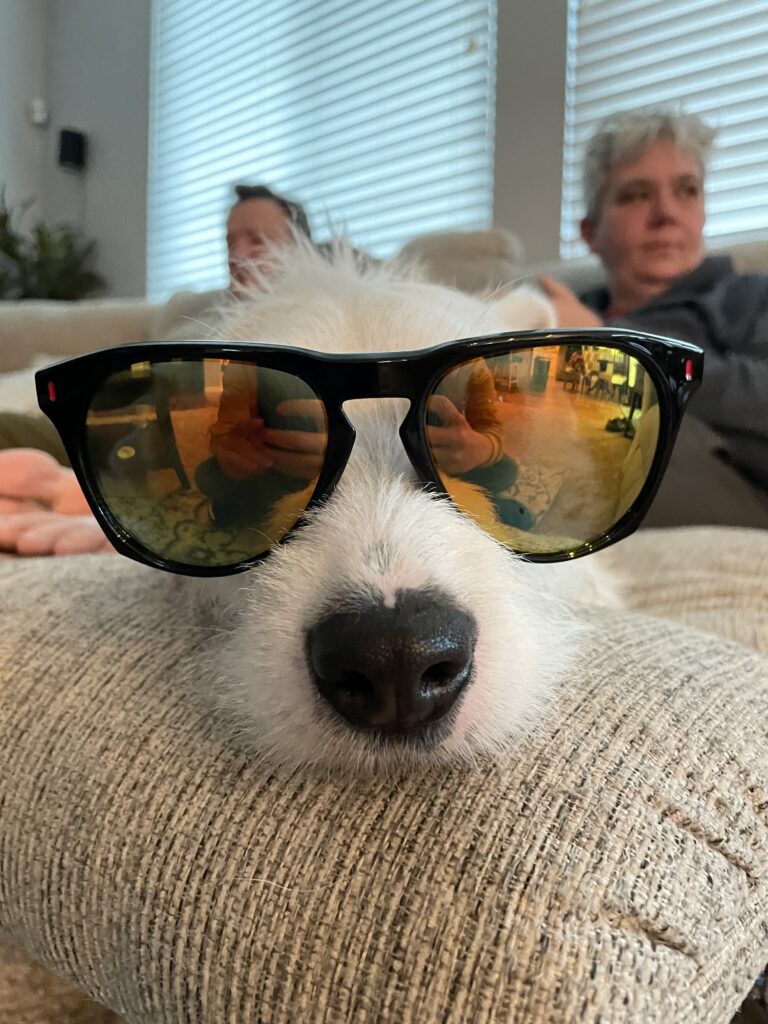
My dogs are not perfect. They do not come every time I ask them. My dogs sometimes bark annoyingly at every thing that walks past the front of our house. My dogs fence fight with the neighbor’s dog. My dogs bark at the neighbors when they start their truck. My dogs dig holes in the yard. My dogs sometimes pull on their leashes. My dogs tend to bounce on visitors at least three times before they settle down.
Why am I telling you this? A lot of dog trainers present a slick and clean narrative of training. Click, treat, done. They don’t show the messy intermediate steps, the struggle to start, the missteps in the middle, the trial and error of learning. Reality is messy and iterative and ideally filled with lots of laughter.
Dogs are living, breathing creatures. They have emotions, drives, plans and objectives of their own. We, as their human counterparts, have all those exact same things. Guess what – they aren’t always going to align, no matter how good our training is. And it is when they don’t align that the challenges, training gaps and behavior problems manifest themselves.
I work with a lot of different dog owners/handlers. From the well loved house pet owner, to the dog sport competitor and the professional working handler. Note, I work with the human – not the dog. I may work with a person to troubleshoot their training/communication with their dog, but I don’t train the dog. I train the human. Regardless of what the human is trying to do with their dog, everyone gets the same basic direction.
Train something every day with your dog. I don’t care what it is – whether skill, trick or service. Every day do focused work with the dog on something. I don’t care about the methodology, process, technique… what matters is the doing. The doing is what builds a connection. The doing is what builds communication. The doing is what builds the relationship. The every day doing is also what will build the human’s skills.
I also instruct everyone to record your training. Use your cellphone to video your sessions. Keep a journal of the work you are doing and the progress you have seen. Set a weekly, monthly, quarterly and yearly task to review your videos and journals. Watch with a critical eye, but also give credit where it is due. Look for things to do better, but also see the things you and your dog are succeeding at or doing better. Look for your successes, just like you look for your dog’s successes. Reward yourself, just like you do your dog. Eventually, training becomes a self-rewarding activity that you and your dog will eagerly anticipate.
“I don’t have time to do that.” I hear this from people all the time. There is a huge misconception that proper training takes lots of time. Over the life of a learned behavior, there may be a good amount of time invested, but the daily commitment is actually pretty small. It’s a commercial break on the television. It’s a few minutes between streamed videos on your phone. It’s the walk to and from the car in the morning and evening if you are taking the dog to daytime boarding. It’s a few minutes at mealtime. It’s a few minutes at the beginning and/or end of your playtime or daily walk. If you have the time to have a dog, then you have the time to teach something every day.
My favorite training sessions are 10 treats long. I put 10 training treats in my pocket (or I use a favorite toy 10 times when using toys as rewards instead of food). I have a clear idea what we are working on and what my criteria is for reward. If I ask for something and the dog fails to meet criteria, I adjust my criteria or the environment to help the dog win or be successful. If the dog seems to really have the idea and is being super successful, I may adjust my criteria or the environment to make it more challenging. But anytime they aren’t successful, I am the one to adjust. When I have a high success rate, the challenge is increased again. As soon as the treats are gone or I’ve played with the toy the requisite number of times or the commercials are over, we end the session – ALWAYS ON A WIN. Always make the very last thing you ask for, something the dog can be successful at 100% of the time. Resist the “just one more” trap as well. End when you said you would. Stop before the dog does. If you let the dog quit the work, you will struggle to get and keep your dog engaged when things get hard. ALWAYS LEAVE THEM WANTING MORE. Equally important, stop training, before you get tired, frustrated or bored. and same for the dog – the dog does have a say in this process as well.
All those things I stated in the first paragraph are true, but my dogs are perfect for me. They do come to me when it is important for them to do so. My dogs don’t misbehave when I have met their emotional, physical and mental needs. My dogs act the clown when they know I need to laugh. Any time my dogs are behaving in a way that I don’t like, I ask a few questions. First I do a self check. Am I angry? Tired? Frustrated? Distracted? I’m always amazed when I realize I’m holding tension in my body or I’m just not present and my dogs are letting me know. They want me with them, in this now and they don’t hesitate to let me know when I’m not. Next I ask, what are my dogs missing? Has it been a while since we’ve done something new? Is it the first nice day in a while and I’m busy doing chores, when we should be out playing in the nice weather? Is something exciting happening and I haven’t let them know what their part in it is? Have I not taught them what is expected, so they are trying to figure it out? Depending on the answers to these questions, I make adjustments and try again. or say, “not right now.”
A well exercised, properly stimulated dog will sleep a lot – 16 to 20 hours a day. That is plenty of down time to get other things done and not have to focus on the dog all the time. There are days my dogs don’t get that much sleep – training, competing in dog sports, working. But most days, they sleep a lot – as long as I’ve given them enough physical and mental stimulation. It usually amounts to a couple of hours total – walks around the neighborhood, training games throughout the day as I take breaks from working, puzzles for them to work out on their own when I’m busy.
When my dogs and I are not aligned in our emotions, plans, drive and/or objectives, we call an audible. I have withdrawn from competition, stepped back from deployment, changed my training plans on many occasions because one of us wasn’t where we needed to be in that moment to do the things we thought we wanted to accomplish. My dogs know when I’m not on and I have learned to understand when my dogs aren’t ready to go too. It’s a two way street and requires a give and take.
But no matter what, we train something every day. Even when we don’t feel like it or are rushed or don’t really want to. We do it even then, because sometimes we have to perform under less than ideal circumstances. This is how we build resilience, patience, perseverance and adaptability. It is how we learn to really read and understand our dogs. It is how we build an amazing relationship with our dogs.
